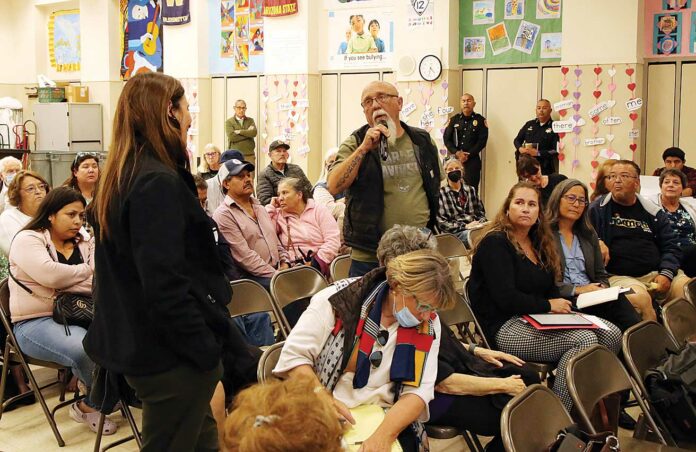
Watsonville City officials hosted a community meeting Monday evening to address unresolved issues and “misinformation” from an April 11 City Council meeting regarding storms and floods that hit the Central Coast at the close of the year and into 2023.
The two-hour meeting, at Ann Soldo Elementary School, targeted residents of the 55-and-older communities of Pajaro and Bay villages and Pajaro Vista. It was designed to engage residents in conversation outside the constraints of a formal city council meeting about the effects of the storms, rising flood waters into homes and neighborhoods, widespread damage and the city and county’s response.
On hand were City Councilmembers Jimmy Dutra and Ari Parker, Watsonville Police Chief Jorge Zamora, Fire Chief Rudy Lopez, Pajaro Flood Management Agency Executive Director Mark Strudley, Assistant City Manager Tamara Vides and others.
“We know how hard those moments on December 31st were for many of you,” said Vides, who headed up the meeting. “One thing I keep thinking about December 31st is how unexpected it was.”
Strudley went on to outline, with the aid of a slide presentation, how officials’ actions were based on weather models that showed rainfall coming on Dec. 31 to be between 1 and 3-4 inches, ranging from the Pajaro Valley to surrounding mountains. The storms, however, delivered a much heavier package of rain. Numerous residents expressed concern about why they weren’t warned about it and the absence of help when flooding began.
“We’re looking at forecast differences of 3, 4, 5 inches less rain than was forecast on the 29th,” Strudley said. “The result was the second highest peak of record on Corralitos Creek, equivalent to about a 50-year flood. The river rose to about 16.2 feet and this is what created all the havoc. This was very serious but we did not know this was coming.”
One result was massive flooding along Corralitos Creek, since there are no levees between East Lake Avenue and Green Valley Road near Holohan Road.
After the initial flood, crews focused on removing wood piled up in area creeks and then reviewed other storms that came through, Strudley said.
Green addressed how the drainage system works around the three senior villages and how they are not designed to handle overflow from area creeks on top of ongoing rains.
She said the pumps at Atri Court have a capacity of about 89 cubic feet per second in the best of conditions.
“You can see the flow from the creek was about two and a half times that, so there was no opportunity for the pumps to keep up with the amount of creek flow that was coming at us; that’s the main reason we saw the flooding that we did.”
Assistant Director of Public Works and Utilities Danielle Green reviewed routine maintenance of the pump system and said it was healthy and on schedule. She did add that one of three pumps at Atri Court did have an electrical short which shut it off for a short spell.
Vides went on to explain that Dec. 31 was a holiday and that once flooding kicked in, the city activated its Emergency Response System, which brought all hands on deck.
Zamora talked about improving law response based on a comment from the crowd.
“This event brought us together and it also overwhelmed us,” he said. “We had five officers working at that time. We are not trained to go into water rescues unless it is absolutely necessary.”
He highlighted issues such as looting, and having to give evacuation orders, only to turn around and tell people they can return, and then evacuate again.
“It’s very frustrating,” Zamora said. “I get it because I’m the one issuing the orders.”
Lopez said he increased staffing during the storms.
“We ran two additional companies; our crews didn’t sleep that night and we had twice the amount of calls that night,” he said, adding that the department has since purchased rescue boats and waders (tall rubber boots).
Environmental Sustainability Manager Jackie McCloud told the crowd how she and crews worked closely well before the storms to clean out storm drains, ready sandbags and other measures based on hydrographs and National Weather Service information.
McCloud said that of the residents in the 100-year flood plain (including all three senior villages), “If you have a mortgage on your property, you are required to have flood insurance.” She advised those people to refer to the City Community Rating System that can give up to a 15% reduction on flood insurance, and encouraged residents to reach out to her for information at 768-3170.
Strudley further added that the main solution to future flooding is the new Pajaro River levee project, and there’s “not a lot we can do before it is built.” But Strudley did say the Army Corps of Engineers has agreed to move the project start date to summer 2024, up from the original 2025.
“We’re going to have to go through one more year, biting our fingernails, so it’s very important for us to be prepared and we pay attention to the storm forecasts as we go through next year,” he said.
Issues covered in the meeting included:
• Flood insurance and renewal issues.
• Clogged culverts that were built to divert flood waters.
• Seniors in flooded homes whose calls to 911 were turned away.
• The retention pond at Bridge Street at East Lake Avenue was overwhelmed with flooding.
• Maintenance records for creeks.
• How can people without computers and phone service, that has been knocked out by storms, communicate with emergency services?












Excellent article and thank you for also outlining additional issues covered.